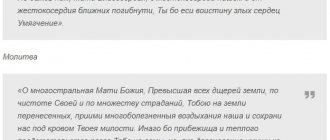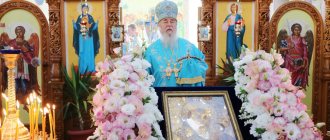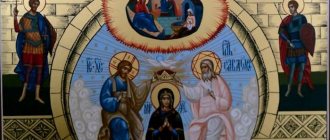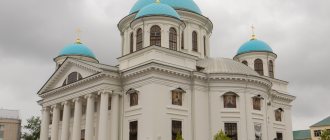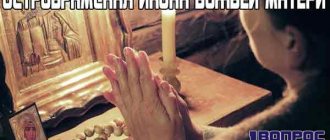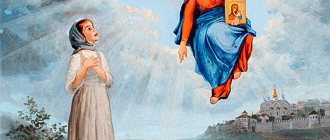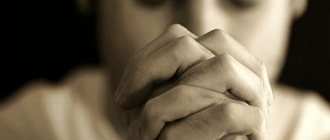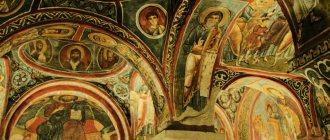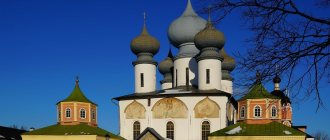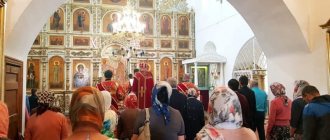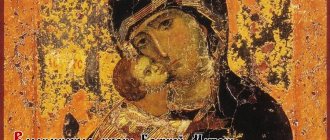The icon “Softening Evil Hearts” is one of the most revered in the Orthodox world. Her veneration is associated with miraculous powers capable of healing physical and spiritual ailments.
“Softening Evil Hearts”... There is so much hope in the name of this icon - the hope that one day truth will triumph on earth, that people will become kind and merciful, and will begin to love each other. And how difficult it is in our cruel world, and sometimes only the sight of someone else’s suffering can soften our own evil heart...
The famous icon has a second name—Simeon’s Prophecy—and is similar to the Seven Shots. However, on the last one the swords are written differently: three on the right and four on the left side of the Mother of God’s heart.
The story of the discovery of the Seven-Arrow Icon of the Mother of God
There is no exact information about the origin of the image. But it is believed that it belongs to the North Russian iconographic tradition. Approximate dating: 15th century. For some time it simply served as an ordinary religious object, but later everything changed.
In the Kadnikovsky district of the Vologda province there lived a peasant who suffered from lameness and other diseases. According to some sources, he worked in the Church of the Apostle John the Theologian and accidentally discovered an ancient icon. According to others, in a dream he heard the voice of God and, at his command, climbed to the bell tower, where he discovered the image.
As it turned out, the workers used the icon as a step, considering it an ordinary board. When the truth was revealed, the clergy restored and served a prayer service in front of her. The peasant who was present with him received complete healing. Since then they believed that the icon was miraculous. She was even transported to Vologda when the plague epidemic was raging.
For about 80 years the image was kept in the Church of St. John the Evangelist, but at the very beginning of the 1917 revolution it disappeared. Since then there has been no information about the original. The seven-arrow icon of the Mother of God is so called because the Virgin Mary is depicted pierced by seven arrows.
Iconography
The image is considered quite rare and authentic due to the fact that the Mother of God does not hold the infant Christ in her arms. Its name is a description, because the Mother of God is depicted with seven arrows in her chest. The iconography is similar to the Orthodox image “Softening Evil Hearts.”
There is also an image with a similar motif, which is called “Our Lady of the Don”. The seven-shot icon looks exactly like this because it is an allegory of the Gospel legend. According to legend, Simeon, who was a Jewish clergyman, took Christ in his arms and realized that he was the son of God.
The righteous man uttered several prophetic words about Jesus, predicted the colossal changes that he would bring to the world, and told the Mother of God “and a weapon will pierce your soul.” It is believed that this is why the Virgin Mary is depicted without Christ in her arms.
There are many traditions of depicting this icon. For example, swords are sometimes written instead of arrows. Their number remains unchanged - seven.
Icon “Softening Evil Hearts”
The very name of the icon (“Softening Evil Hearts”) awakens hope for a solution to problems, the reign of truth, mercy and kindness, love and mutual understanding. Such thoughts occur not only in the context of the perception of the external world, but also in connection with the soul’s own imperfections, which can be smoothed out through prayer and piety to the Mother of God.
History of the origin of the icon
It is officially believed that the image of the icon “Softening Evil Hearts” first appeared on the territory of South-Western Rus'. And yet, accurate historical data about this does not exist. The appearance of the image is not recorded by any historical sources, which indicates the antiquity of this Face.
Interpretation of the icon
The icon depicts the Most Pure One with seven swords pierced into her heart. This number itself in Orthodoxy symbolizes completeness, fullness. In this case, seven swords are a symbol of the filling of the heart of the Mother of God with endless grief, sadness and pain endured by the Mother of God during the period of her earthly existence.
Swords piercing the heart are depicted three to the right and left of the heart, and one is pierced into it from below. In some cases the Primordial Child is present in the image.
Evangelical meaning
Sometimes this icon is called “Simeon’s prophecy.” When Mary came to the temple, Elder Simeon, who could not die without seeing the Savior (thanks to the promise of God), looked at the Holy Spirit. He realized that this boy was the Son of God. He enlightened Mary about his fate. Then he told her that the weapon would also pierce her soul, revealing the thoughts of other people’s hearts. The elder compared the torment of the soul with bodily pain.
The image of the seven sins
This image indicates all seven basic sins of humanity that corrupt people’s souls. These are pride, anger, greed, adultery, envy, despondency, gluttony. They all threatened the Blessed Virgin during the Great Trial. Having withstood all the temptations, the Mother of God, with a humble soul and faith in the Almighty, was able to overcome it.
When looking at the icon and turning to it, it is necessary to remember that the Mother of God, through this image, can see the sin that aggravates the soul, and at the same time help to humble the heart, getting rid of the sinful burden. She reminds us of the need for humility and resilience when adversity comes our way in life.
Miracles icons
Many believe that the time of true miracles passed in ancient times. But this is far from true. Even in the years when young people were convinced of the absence of God, He did not forget about His children. Thus, during the Great Patriotic War, when the southern part of the Voronezh region was occupied by Nazi Italian units of mountain riflemen, in one of the destroyed houses soldiers found the image “Softening Evil Hearts.” The soldiers of Lieutenant Giuseppe Perego's platoon on these cold December days of 1942 were not flattered by the outlandish painting, but took it to the military chaplain. Father Policarpo from Valdani placed the image among the shrines available in the camp church.
Catholics were also drawn to the image of the Mother of God, which, it turns out, came directly from the Resurrection Belogorsk Monastery. They called her the “Don Madonna,” which in their language sounds like “Madonna del Don.” The soldiers of the invading army prayed to the Mother of God for salvation. Many remained confident that, thanks to her intercession, death had passed them by.
When the corps of the defeated army headed home in January 1943, many soldiers were surprised by the mercy shown to them by the women of the lands they had devastated. Frostbite and hunger that plagued the retreating troops could have killed most of the soldiers. If it were not for the kind hearts of women, then there would be no one to return to Italy. To this day, veterans remember the word “potato”, since it was the only product that housewives could find in their cellars.
The icon that the soldiers gave to their chaplain went with them all the way. Father Policarpo did not keep her, but brought her to Italy, where a separate chapel was built especially for her in Mentra. On September days, even now, veterans of that war, their relatives and friends gather here. They tell the younger generation about what they experienced, about all the horrors of the military campaign and about their salvation by the Mother of God, who even now looks at them from the icon. Here they remember the dead and order a prayer service for the repose of their souls.
There is another image, “Softening Evil Hearts.” It, being a copy of the original, showed such a quality as myrrh-streaming. Previously, this happened extremely rarely, but in the twentieth century this property was revealed in many icons, and it is progressing.
The myrrh-streaming icon “Softening Evil Hearts” is now often transported throughout our vast country. But she doesn’t react exactly the same to the ground where she is. Before the days came when Moscow suffered from explosions, the image of the Virgin Mary on the icon changed subtly. Looking closer, people saw that shadows and black circles appeared under her eyes. The apartment where she stood was filled with the smell of incense, which did not dissipate until the explosions stopped completely.
Another time, cuts and sores were noticed on the arms and neck of the Virgin Mary. Red lines and dots became harbingers of the death of the Kursk submarine.
On the day of the Archangel Michael, the icon again became myrrh. At the same time, her tears turned red with blood. This mixture can easily be collected on cotton wool. Since then, bloody tears have been flowing without stopping.
The blood of “Softening Evil Hearts” is released most strongly upon contact with the Russian military. More than once, Marines and other soldiers were surprised to see blood appear on their snow-white gloves.
Now the icon is traveling around the world. She has already visited many countries, and many are waiting for her arrival. On December 8, 2011, she was brought to Italy. Here she was placed in the sanctuary, where the one who was brought during the war was located. Many people came here to worship and ask for blessings from the Mother of God. At parting, Orthodox priests carried out anointing with myrrh, which gathered at the icon. In the end, even the Catholic priests and monks could not stand it, so they came up to also receive confirmation from the Mother of God.
The meaning of the Seven Arrow Icon in Orthodoxy
The sacred meaning of the image lies in the number of swords or arrows with which the Virgin Mary is depicted. There are two main interpretations. The first says that the number of weapons can be compared with the number of mortal sins of humans.
The icon means that the Mother of God, like her son, takes upon themselves the sinful passions of all the people of the world. Self-sacrifice, acceptance of fate and deep mental anguish are the main motives of the image.
According to another interpretation, seven is a sacred symbol. Since ancient times, the Church has had the concept of seven main virtues, sins and sacraments. This number means completeness, completeness and perfection. The seven arrows or swords symbolize the suffering of Christ during the Passion Days, which the Mother of God also accepted.
How does “Seven Shot” differ from the “Softening Evil Hearts” icon
These images are very similar in motives and manner of writing. The difference is that in the “Seven Shot” swords are located on two sides, 3 and 4 on the left or right. And “Softening Evil Hearts” is written with three arrows to the right, three to the left and one below the Virgin Mary.
Another difference that only professionals will notice is the iconographic tradition. If “Semistrelnaya” belongs to the North Russian, then “Ugleniye” belongs to the southwestern one.
The icons were painted at different times. It is assumed that the original “Seven Shot” was created in the 15th century, after which many copies were made. There is no dating at all for the “Softening Evil Hearts” icon, but it is believed that it was painted approximately in the 18th century.
On the left is the “Seven Arrow” icon, on the right is “Softening Evil Hearts”
The legend of the acquisition of a miraculous image
Tradition has preserved for us the story of the miraculous appearance of this image. It tells how a peasant who lived near Vologda suffered from lameness for many years. No matter how much he turned to doctors and healers, he received no help. He had already humbled himself and was ready to bear this cross until the end of his days.
But then one day in a dream, a peasant heard a mysterious voice, commanding him to go to the Theological Church for healing, and there, in the bell tower, where the old, dilapidated icons were kept, to find the image of the Most Holy Theotokos and pray in front of it. With all his soul the peasant believed what he heard and went to church. However, it took a long time to persuade the clergy to allow him to undertake the search. Only after asking three times did they go up to the bell tower with him.
Here, to their horror, they actually discovered an icon of the Virgin Mary, covered with a layer of dirt. It was used as a simple board on the stairs. This was the icon “Softening Evil Hearts.” There was obvious sacrilege, because the image, even if old, was stepped on while climbing the stairs. When the icon was thoroughly washed, it was taken to the church and prayed for. Soon the lameness left the peasant.
How does the Seven-Shot Icon of the Blessed Virgin Mary help?
The original image is known for its healing properties. This has led to the creation of many lists. They are used in temples, hung at home, and addressed to her with various prayers. It is believed that, first of all, the icon protects children from illness and any evil. A prayer said by the mother before this image will protect the baby and help him grow healthy and strong.
The Mother of God is the ideal woman. She can be called pure, compassionate loving. It is believed that the icon will protect from any adversity, help not to stray from the righteous path, and bestow harmony and peace in the home. Before “Semistrelnaya” they pray for sons who have gone to serve in the army or are participating in hostilities.
Mothers offer prayers to the Mother of God, asking to end the war as soon as possible and return their children home safe and sound.
It is also believed that the icon protects the house from scammers, thieves and all those who want to harm the family. It protects against envious people and slanderers, damage and the evil eye, witchcraft and love spells.
There are no strict rules about what to ask of Our Lady. The main thing is that the prayer comes from the heart, and that your thoughts are pure.
There is a sign that if the Seven-Arrow Icon falls, it means evil people are trying to enter the house or family. Thus, she seems to warn the owners against the dangers.
Icon from the Don shores
There is an interesting story connected with the “Softening Evil Hearts” icon that happened during the Second World War. On the banks of the Don, near the city of Pavlovsk, there was an Italian military unit that fought on the side of the Germans. Soviet artillery fired massively at the area where the Italians were located. Wanting to hide from the fire and save themselves from certain death, the soldiers hid in chalk caves, which are found in abundance on the banks of the river. And then one of the Italians found an ancient icon in the cave labyrinths.
This was one of the copies from the “Softening Evil Hearts” icon. When the fire died down, he took it to the regimental chaplain. Italians are also Christians, although they profess Catholicism. The chaplain, realizing the value of the find, placed the icon in the camp church. It soon became clear that the found icon had previously been located in a cave monastery blown up by the Bolsheviks. The Italians called it the Don Icon in honor of the river on the banks of which they found it.
The miraculous image brought these Italians alive from the fire of that terrible war, who had become bargaining chips in someone else’s ruthless political game. Veterans of the regiment testified that they saw their relatives again only thanks to the intercession of the Mother of God, sent down through the icon, which they continue to call Donskaya.
Thus, the Most Pure Mother of God shows her help and mercy through icons that are very close and similar, like sisters. These are the “Softening of Evil Hearts”, the “Seven Arrow” icon and the “Donskaya” icon, now kept in Italy. They belong to a single iconographic type and are united in their spiritual content.
That's how amazing it is - the ancient icon “Softening Evil Hearts.” What does she protect us all from? Probably from ourselves, from our malice and anger. And if, after prayers addressed to the icon, the heart of each of us softens, then the arrows of suffering will stop piercing the chest of the Most Holy Theotokos.
Where is the image
At the moment, the location of the original icon is unknown. During the revolution she disappeared from Vologda. In the 1930s, service in the Church of St. John the Evangelist ceased. It was only restored in 2001. By that time, any mention of the original icon had disappeared. There is a version that it was taken abroad and is now in a private collection.
However, from the 19th century, lists began to be created from this image. The holy icon appeared in many churches throughout the country. The most famous list is considered to be the image that began to flow myrrh. A woman named Margarita and her husband Sergei purchased the image in Moscow.
It was an unremarkable product, printed at a large printing enterprise. But now it is the most famous myrrh-streaming icon in modern Orthodoxy. Sergei travels all over the world to show the miracle to as many people as possible.
For a long time it was not clear why she was streaming myrrh, but one day during a service in Murmansk a small child touched her and exclaimed “She is crying!” Then all those present understood that this was how the Mother of God grieved for all the troubles and sins of mankind.
In the village of Bachurino there is a copy of the icon, which bleeds from time to time. This happens during times of strong shocks, disturbing news and tragedies. For example, they first noticed that the Semistrelnaya was bleeding during the sinking of the Kursk submarine.
The myrrh-streaming icon and the Temple of the Icon of the Mother of God “Softening Evil Hearts” in the village of Bachurino
History of the icon
At present, little is known about the origin of the shrine, and many scientists put forward a variety of points of view on this matter. Among them there is one very common one, according to which the myrrh-streaming icon “Softening Evil Hearts” was created by foreign Catholic believers, who subsequently decided to voluntarily hand it over to the ancient Russian state.
The legend says that once upon a time, one serf peasant had a chance to experience very difficult times that accompanied his life with the manifestation of incessant pain. And one night, while in a deep dream, the elder heard a strange voice that kept coming from different sides of the room.
He spoke about the ancient Church of St. John the Evangelist and its bell tower. It was there that the icon of the Mother of God “Softening Evil Hearts” was located, capable of helping the peasant eliminate the unpleasant and terrorizing illness. However, her canvas had to be found among numerous shrines, which were kept from prying eyes in a specially designated place. Having discovered the Softening icon right inside the bell tower, the peasant prayed and was immediately healed.
Many Orthodox believers, in order to honor the memory and pray before the icon of the Mother of God “Softening Evil Hearts,” go to Moscow on Sundays. Since a beautiful temple of the Archangel Michael was erected on the territory of the capital, where this icon is now located. Other exact lists of it can be found by visiting the Church of St. Lazarus, located in Volgograd or in the Moscow region inside the Church of the Mother of God.
How to pray to an icon correctly
When performing this sacred rite, you must follow the following rules:
- You need to speak quietly and meekly, ask, but not demand.
- Before and after reading the prayer, you must make the sign of the cross three times.
- Prayer should be done on your knees.
- After you have read the canonical texts, you can turn to the Mother of God with a personal request.
- You cannot ask for sorrows and troubles for other people. The heart and thoughts of the person asking must be pure.
Recently, so-called audio prayers have become popular. These are audio recordings of other people. The authors claim that simply listening to them is enough. But that's not true. You yourself must turn to the Mother of God.
Texts of prayers
It is believed that three canonical texts must be pronounced at the icon.
Troparion:
Soften our evil hearts. Mother of God, / and extinguish the misfortunes of those who hate us, / and resolve all the tightness of our souls, / looking at Your holy image, / We are touched by Your suffering and mercy for us, / and we kiss Your wounds, / and we are horrified by our arrows that torment You. / Do not let us, Mother of Grace, / perish in our hard-heartedness and from the hard-heartedness of our neighbors, / for you are truly the softener of evil hearts.
Kontakion:
“To the chosen Virgin Mary, above all the daughters of the earth, the Mother of the Son of God, who gave Him the salvation of the world, we cry with tenderness: look at our many-sorrowful life, remember the sorrows and illnesses that you endured, like our earthly-born, and do with us according to Your mercy , let us call You: Rejoice, much-sorrowful Mother of God, transforming our sorrow into joy.”
Prayer:
“O long-suffering Mother of God, Higher than all the daughters of the earth, in Your purity and in the multitude of sufferings You have brought to the earth, accept our much-painful sighs and keep us under the shelter of Your mercy. Do You know of no other refuge and warm intercession, but, since You have the boldness to be born of You, help and save us with Your prayers, so that we may without stumbling reach the Kingdom of Heaven, where with all the saints we will sing praises in the Trinity to the one God, now and ever, and forever and ever. Amen".
Where to hang it in the house
There are no strict principles for placing icons in a home. It is best to place the image “Softening Evil Hearts” in a home iconostasis. Many people hang a face over the passage from the hallway to the living room so that the Mother of God greets those entering the house.
If there is no iconostasis, then the icon is placed in any convenient place in the eastern part of the room. It is advisable for the face to look at the door, so the Mother of God will protect the home from guests who come with bad intentions. Photographs, paintings, and decorative elements should not be placed next to the icon. You cannot place the image in the same corner as the TV.
Miracles associated with the icon
This image was first talked about as miraculous back in the 18th century. The peasant who discovered the icon was cured of lameness and other ailments after a prayer service at the icon. The clergy who were in the temple recognized that the miraculous icon really has healing properties. This was soon tested in practice.
In the mid-19th century, a cholera epidemic broke out in the Vologda province. Thousands of people died from a terrible disease, and the medicine of those years could not offer anything to patients. Then the priest of the Church of St. John the Evangelist gathered all the believers and made a religious procession through the city and the surrounding area. After which the epidemic immediately subsided.
Another miracle that is associated with the copy of the original icon occurred during the Second World War. A detachment of Italian soldiers raided villages. This icon was discovered under the rubble of one of the houses. Religious Italians were so impressed by the image that they stopped all hostilities against civilians and left the village. They called the icon “Don Madonna”.
The seven-shot icon of the Mother of God is, first of all, a symbol of eternal maternal love, protection and patronage. It symbolizes grief for all those killed and injured during the endless wars waged by people. Prayers addressed to the Mother of God in this image will help protect children and the house from evil.
View all icons in the SUNLIGHT catalog
20.10.21
A new miracle revealed by the icon
Miracles revealed by holy icons are not uncommon in Rus'. So the miraculous icon “Softening Evil Hearts” could have been lost among other holy images, if not for a new miracle that glorified it. In previous centuries, epidemics often occurred in our country, sometimes claiming tens of thousands of lives. One such epidemic occurred in 1830. Having captured the North of Russia, it caused terrible devastation in Vologda.
With the blessing of the ruling bishop, the icon of the Mother of God “Softening Evil Hearts” was transferred to Vologda and placed in one of the churches of the city. Pious townspeople greeted the shrine with a religious procession. The flow of people to her never ceased. This is not surprising, because the prayer to the icon “Softening Evil Hearts” brought healing from illnesses and help in everyday troubles.
Unfortunately, the fate of the icon after the revolution is unknown. In 1930, the Church of St. John the Theologian, where the image was located, was closed, and services there resumed today. But that icon disappeared without a trace.
